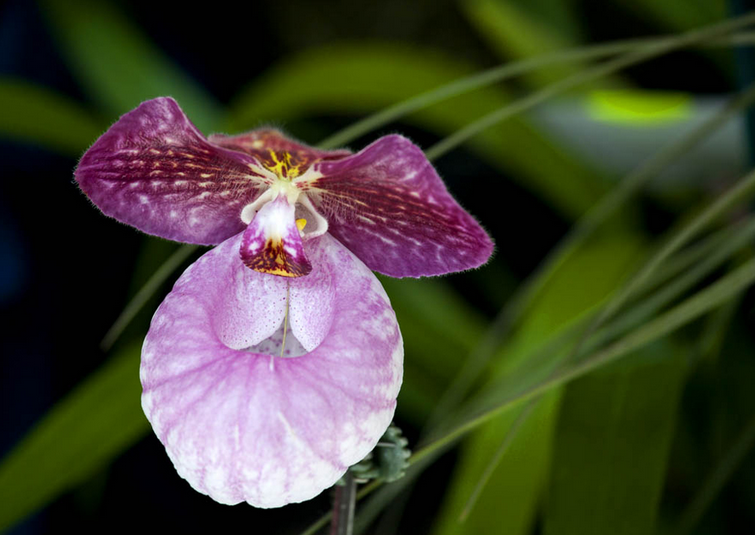How to raise Aristolochia
How to raise Aristolochia? Aristolochia is native to tropical Asia, with peculiar flower pattern and long flowering period. it is usually divided into two types according to its growth form: one is native to alpine cool areas, with all green leaves, bright flowers, cold and cold sex, summer dormancy, and flat land is not easy to cultivate; the other kind of leaves are striped, warm and humid, blossom in summer and autumn, and can be cultivated on flat land. Therefore, the cultivation of Paphiopedilum should first choose the appropriate species or varieties according to the specific conditions.
Although Paphiopedilum is a geophytic orchid, its root is covered with hairy whiskers, and its structure is different from that of other terrestrial orchids. The cultivation medium requires the use of a mixture of organic matter, such as water moss, serpent sawdust, sawdust, saprophytic leaves, humus soil, peat soil and so on. With serpent sawdust: peat soil: humus soil: gravel or brick is better prepared according to the ratio of 6 to 2, 1, 1, 1, 1, 1, 1, 1, 1, 1, 1, 1, 1, 5, 5, 5, 5, 5, 5, 5, 5, 1, 5, 5, 5, 5, 5, 5, 5, 5, 5, 5, 5, 5, 5, 5, 5, 5, 5, 5, 5, 5, 5, 5, 5, 5, 5, 5, 5, 5, 5, 5, 5, 5, 5, 5, 5, 5, 5, 5, 5, 5, 5, 5, 5, 5, 5, 5, 5, 5, and the medium should be pressed slightly after planting, so that the root and medium are fully close. The appropriate time for changing pots is when the weather turns cool in autumn or after the flowers fade.
The suitable temperature for the growth of green leaf variety and variegated leaf variety is 12: 18 ℃ and 15: 25 ℃, respectively, but it can still survive above 30 ℃, and the growth is close to a standstill state, but the temperature can not exceed 22 ℃ from March to June every year, otherwise it will affect the flowering. Paphiopedilum requires 60% to 70% shading in summer, 40% to 50% in spring and autumn, and must not be directly exposed to the scorching sun.
As for the temperature requirements, unlike other orchids, the air humidity is only 40% and 60%. On the contrary, the medium in the basin should remain slightly moist and replenish water in time when it is dry. When the winter temperature is lower than 10 ℃, watering should be stopped to prevent cold damage. Fertilizer can be placed in the basin with a small amount of slow-acting fertilizer, or mature bean cake fertilizer and bone meal can be used at least once a month. Usually use 1 500 × 2 000 times water soluble available fertilizer and spray it once every 20 to 30 days. Non-flowering orchid plants should use nitrogen, phosphorus and potassium fertilizer with a balance of three elements, while near-flowering individuals should supplement more phosphorus and potassium fertilizer to promote more flowering orchids.
How to raise Aristolochia mandshurica
At present, there are many people who love Paphiopedilum, but at present, the cultivation of Paphiopedilum is not common, mainly because many orchids do not grasp its growth habits, resulting in repeated setbacks in cultivation. According to the morphology, Aristolochia can be divided into two categories: green leaf species and variegated leaf species. the green leaf species have all green leaves, large flowers and bright colors, which are native to cool areas in high mountains, but it is not easy to cultivate in flat land, while variegated leaf species prefer sunlight and temperature, and can bloom normally on flat land. Let's introduce how to raise Paphiopedilum in detail.

- Prev

How to raise Phalaenopsis in the North
How to raise Phalaenopsis in the north? Phalaenopsis is a single-stemmed aerial orchid, which is originally from the subtropics. It is deeply loved by people because of its beautiful flowers and bright colors. However, because Phalaenopsis has very strict requirements on temperature and humidity, it limits its natural cultivation area, which makes the majority of orchid lovers
- Next

Culture method of potted flower and leaf taro
Potted flower-leaf taro culture method, flower-leaf taro alias colorful leaf taro, dichromatic taro. Its leaves are shaped like ivory, the leaves are covered with a variety of colorful patterns, bright colors, constitute a natural pattern, quite beautiful. For example, decorate 1 or 2 pots of taro with asparagus, ivy, ferns, etc.
Related
- Fuxing push coffee new agricultural production and marketing class: lack of small-scale processing plants
- Jujube rice field leisure farm deep ploughing Yilan for five years to create a space for organic food and play
- Nongyu Farm-A trial of organic papaya for brave women with advanced technology
- Four points for attention in the prevention and control of diseases and insect pests of edible fungi
- How to add nutrient solution to Edible Fungi
- Is there any good way to control edible fungus mites?
- Open Inoculation Technology of Edible Fungi
- Is there any clever way to use fertilizer for edible fungus in winter?
- What agents are used to kill the pathogens of edible fungi in the mushroom shed?
- Rapid drying of Edible Fungi

